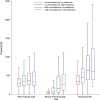90-Day Bundled Payment Simulation, Health Care Utilization, and Complications following Craniopharyngioma Resection in Adult Patients
- PMID: 36097499
- PMCID: PMC9462965
- DOI: 10.1055/s-0041-1740395
90-Day Bundled Payment Simulation, Health Care Utilization, and Complications following Craniopharyngioma Resection in Adult Patients
Abstract
Context Bundled payment and health care utilization models inform cost optimization and surgical outcomes. Economic analysis of payment plans for craniopharyngioma resection is unknown. Objective This study aimed to identify impact of endocrine and nonendocrine complications (EC and NEC, respectively) on health care utilization and bundled payments following craniopharyngioma resection. Design This study is presented as a retrospective cohort analysis (2000-2016) with 2 years of follow-up. Setting The study included national inpatient hospitalization and outpatient visits. Patients Patients undergoing craniopharyngioma resection were divided into the following four groups: group 1, no complications (NC); group 2, only EC; group 3, NEC; and group 4, both endocrine and nonendocrine complications (ENEC). Interventions This study investigated transphenoidal or subfrontal approach for tumor resection. Main Outcome Hospital readmission, health care utilization up to 24 months following discharge, and 90-day bundled payment performances are primary outcomes of this study. Results Median index hospitalization payments were significantly lower for patients in NC cohort ($28,672) compared with those in EC ($32,847), NEC ($36,259), and ENEC ($32,596; p < 0.0001). Patients in ENEC incurred higher outpatient services and overall median payments at 6 months (NC: 38,268; EC: 49,844; NEC: 68,237; and ENEC: 81,053), 1 year (NC: 46,878; EC: 58,210; NEC: 81,043; and ENEC: 94,768), and 2 years (NC: 58,391; EC: 70,418; NEC: 98,838; and ENEC: 1,11,841; p < 0.0001). The 90-day median bundled payment was significantly different among the cohorts with the highest in ENEC ($60,728) and lowest in the NC ($33,089; p < 0.0001). Conclusion ENEC following surgery incurred almost two times the overall median payments at 90 days, 6 months, 1 year. and 2 years compared with those without complications. Bundled payment model may not be a feasible option in this patient population. Type of complications and readmission rates should be considered to optimize payment model prediction following craniopharyngioma resection.
Keywords: bundle payments; complications; craniopharyngioma; economics.
Thieme. All rights reserved.
Conflict of interest statement
Conflict of Interest None declared.
Figures


Similar articles
-
Implications of Payment for Acute Myocardial Infarctions as a 90-Day Bundled Single Episode of Care: A Cost of Illness Analysis.Pharmacoecon Open. 2022 Nov;6(6):799-809. doi: 10.1007/s41669-022-00328-4. Epub 2022 Feb 28. Pharmacoecon Open. 2022. PMID: 35226305 Free PMC article.
-
Bundled Payment Models in Spine Surgery: Current Challenges and Opportunities, a Systematic Review.World Neurosurg. 2019 Mar;123:177-183. doi: 10.1016/j.wneu.2018.12.001. Epub 2018 Dec 12. World Neurosurg. 2019. PMID: 30553071
-
Simulated bundled payments for four common surgical approaches to treat degenerative cervical myelopathy: a consideration to break the clinical equipoise.J Neurosurg Spine. 2022 Jan 14;37(1):49-56. doi: 10.3171/2021.10.SPINE211105. Print 2022 Jul 1. J Neurosurg Spine. 2022. PMID: 35171836
-
Refining risk adjustment for bundled payment models in cervical fusions-an analysis of Medicare beneficiaries.Spine J. 2019 Oct;19(10):1706-1713. doi: 10.1016/j.spinee.2019.06.009. Epub 2019 Jun 18. Spine J. 2019. PMID: 31226386
-
Closing the quality gap: revisiting the state of the science (vol. 1: bundled payment: effects on health care spending and quality).Evid Rep Technol Assess (Full Rep). 2012 Aug;(208.1):1-155. doi: 10.23970/ahrqepcerta208.1. Evid Rep Technol Assess (Full Rep). 2012. PMID: 24422914 Free PMC article. Review.
Cited by
-
Improved healthcare utilization and economic outcomes of chronic subdural hematoma treatment with middle meningeal artery embolization compared to conventional surgical drainage.Interv Neuroradiol. 2025 Jan 17:15910199241311628. doi: 10.1177/15910199241311628. Online ahead of print. Interv Neuroradiol. 2025. PMID: 39819108 Free PMC article.
References
-
- Müller H L. Craniopharyngioma. Endocr Rev. 2014;35(03):513–543. - PubMed
-
- Karavitaki N, Cudlip S, Adams C B, Wass J A. Craniopharyngiomas. Endocr Rev. 2006;27(04):371–397. - PubMed
-
- Bunin G R, Surawicz T S, Witman P A, Preston-Martin S, Davis F, Bruner J M. The descriptive epidemiology of craniopharyngioma. J Neurosurg. 1998;89(04):547–551. - PubMed
-
- Nielsen E H, Feldt-Rasmussen U, Poulsgaard L. Incidence of craniopharyngioma in Denmark (n = 189) and estimated world incidence of craniopharyngioma in children and adults. J Neurooncol. 2011;104(03):755–763. - PubMed
-
- Torres L F, Reis Filho J S, Netto M R.Craniopharyngioma: clinical, epidemiological and pathological findings in 25 cases [in Portuguese] Arq Neuropsiquiatr 199957(2A):255–260. - PubMed

